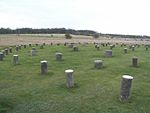Amesbury railway station
AmesburyDisused railway stations in WiltshireFormer London and South Western Railway stationsPages with no open date in Infobox stationRailway stations in Great Britain closed in 1952 ... and 3 more
Railway stations in Great Britain opened in 1902South West England railway station stubsUse British English from February 2018

Amesbury railway station was a station in the county of Wiltshire in southern England. It was located on the Bulford Camp branch line, which diverged from what is now known as the West of England Main Line at a triangular junction between Grateley and Idmiston Halt. When it was open, Amesbury was the nearest station to Stonehenge and carried a lot of traffic to the military areas in and around Salisbury Plain, particularly during the Second World War in the preparations for D-Day.
Excerpt from the Wikipedia article Amesbury railway station (License: CC BY-SA 3.0, Authors, Images).Amesbury railway station
London Road,
Geographical coordinates (GPS) Address Nearby Places Show on map
Geographical coordinates (GPS)
| Latitude | Longitude |
|---|---|
| N 51.17542 ° | E -1.7661 ° |
Address
Tesco (Tesco Amesbury Superstore)
London Road
SP4 7RT , Amesbury
England, United Kingdom
Open on Google Maps







